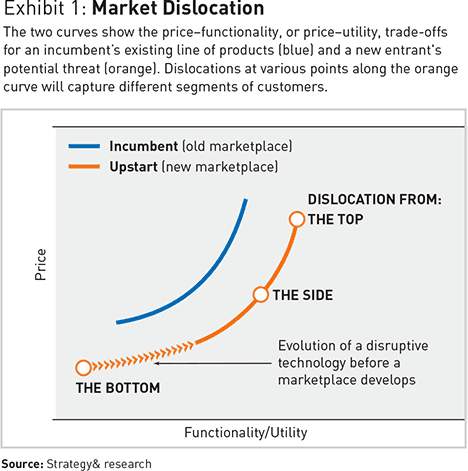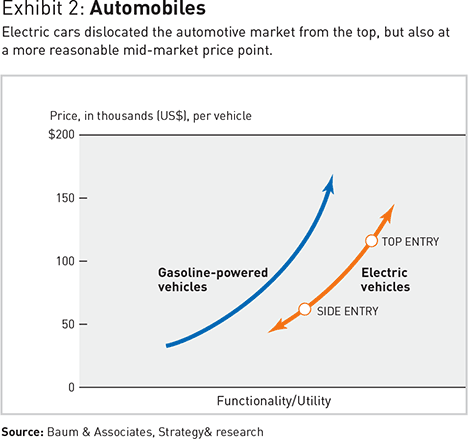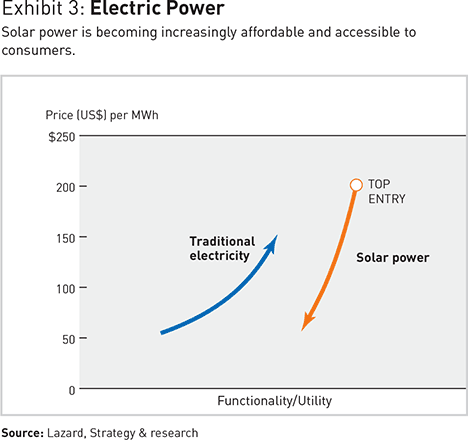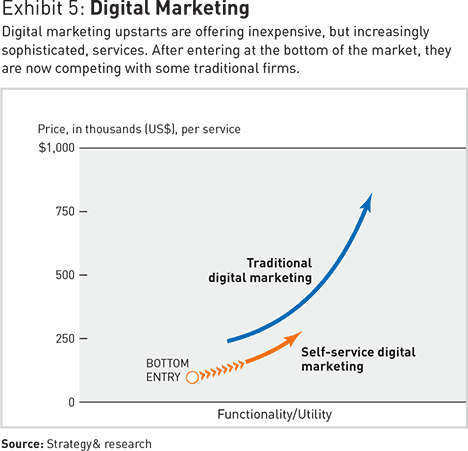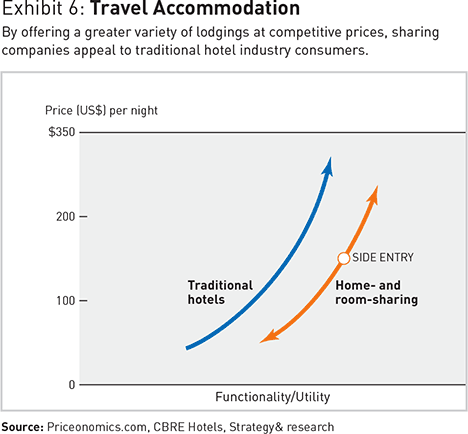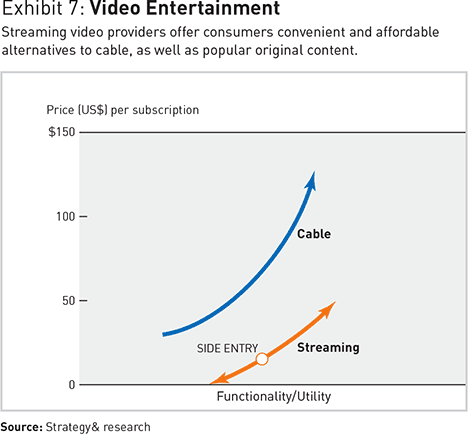Diagnosing Dislocation
Don’t assume the new entrant in your market is a disruption. Learn to recognize different types of threats and design the best strategic response.

Imagine that you run a large company, prominent in its industry, with a loyal customer base and strong profit margins. Suddenly, a new product comes along that threatens your existence. It could be a technological development that will render your main product obsolete, just as streaming video is doing to cable television. It could be a more user-friendly way to obtain a similar product or service: Think of the sharing economy versus the traditional hospitality industry. Or it could be a creative new approach to existing offerings, such as the use of mini-clinics and telemedicine services instead of conventional physicians’ groups and hospitals.
As the incumbent being threatened, you want to preserve your business and compete effectively. You quickly confront challenging questions: Should you rapidly emulate what the new entrant is doing? Or would it be better to double down on your existing products and services? All too often, when deciding how to respond, companies assume that they are facing a disruption — following the term coined by Harvard Business School professor Clayton M. Christensen. He defined a disruption as an innovation that allows upstarts to build a new market from the bottom up by initially offering simpler, cheaper products and services, often with fewer features or reduced capabilities, but also with a much lower price that appeals to a customer group the incumbents have ignored.
But new products and services can enter your market from other directions, each distinct in terms of how, where, and when it affects your business. These are market dislocations — radical breakaways from the existing market that occur when a company introduces a business model or a product that sits apart from those of competitors. Some dislocations come from the top down: They expand the market by giving high-end customers prestige and luxury at a premium price at first. Then, as the new entrants gain prowess and reputation, they add middle-range alternatives that compete with incumbents. One recent example is Tesla’s move from high-end electric sports cars to sedans with a US$35,000 list price. Elsewhere, as solar technology has become cheaper, renewables have begun to threaten traditional energy companies. Still other dislocations, such as the trend toward home- and room-sharing through online rentals, threaten incumbents from the side. Here, there may be no significant price difference. But the upstart provides accessibility and features that incumbents cannot offer or have chosen not to offer.
Then, of course, there are bottom-up dislocations, or disruptions. In these cases, as the new entrants gain market share and proficiency, they add features and versatility. This combination of lower prices and innovation ultimately allows them to replace the old market leaders entirely. For example, as Christensen recounted in The Innovator’s Dilemma (Harvard Business School Press, 1997), the first hydraulic earth movers, in the 1950s, were too small and imprecise for the industry’s typical customers: large construction firms that dug sewers and mines with expensive cable-based heavy equipment. The hydraulic upstarts (companies such as Caterpillar, Deere & Company, and Komatsu) sold instead to an emerging market — house builders. Gradually, they improved their equipment and expanded their customer base. Similar dynamics have been observed in personal computers, disk drives, steel, entertainment retailing (bookstores, video stores, and record stores), home furnishings (for example, from IKEA), digital photography, and many other industries.
Not all upstart threats are alike; misdiagnosing your competition can bring harm to your business.
Clearly, not all upstart threats are alike — and misdiagnosing your new competition can lead you to respond in a way that can bring further harm to your business. Incumbents often move early into new technologies, even if it means undermining or cannibalizing their existing businesses. Sometimes that’s the right thing to do. But other times it can backfire in devastating ways. Instead of acting rashly, incumbents should take a step back, determine what type of dislocation they are facing, and respond with the appropriate tools and strategies. Not doing so can lead to lost customers and slipping profits — or worse.
Anatomy of the Threat
The key to understanding any upstart threat is to study the way its innovations alter the marketplace. This can be boiled down to the curves shown in Exhibit 1: product/service price versus functionality. The blue curve represents industry incumbents, which have a range of potential price-versus-functionality variations that they profitably offer. They can’t put forward all possible variations — they can’t fill in the entire curve. But everything the incumbents offer will fall somewhere on that blue curve, because that’s where the constraints of the incumbents’ technology and capabilities will place all its products.
The orange curve represents the new technological frontier. Each startup that changes the market enters with its own point on this curve. And every combination of price and functionality will expand the market in some way, drawing in customers. The challenge for the incumbent is to identify where the upstart is breaking in. Is it capturing previously overlooked or underserved customers at the bottom of the market, with lower price and less functionality? Is it capturing customers at the top, with highly valuable offerings that few can afford? Or is it coming in from the side, luring some of the incumbent’s existing customers with extra accessibility or features at similar prices?
Thus, for example, in a typical city, the blue curve could represent the transportation offerings of an existing taxi service or mass-transit agency. New offerings by an Internet-managed ride-sharing service, such as Uber, Lyft, Sidecar, or Haxi, might come in at the bottom, with lower-cost ride-sharing and carpooling apps; they might come in at the top, with premium services as comfortable as limos; or they might come in from the side, offering convenience in hailing, scheduling, and paying for vehicles. Sooner or later, they might migrate to offer all three levels, thus pressuring the existing taxi and mass transit providers to adapt or fail.
No matter where they enter, dislocations do not simply extend the existing market. Rather, they establish a radically new position with respect to price and functionality. Whereas price is defined purely by the market, functionality is a matter of customer perception. Of course, different customers prefer different options. Purchasers of all-electric cars, for example, have about a dozen manufacturers to choose from, and customers have their own reasons for preferring one over the others. Similarly, solar power may be highly prized by some customers, and not at all important to others. Therefore, functionality will always be partly subjective.
Market dislocations establish a radically new position with respect to price and functionality.
New entrants develop their sustainable competitive functionality in several different ways. For example, technological advances often lead to upstart products with superior functionality. Customers defect en masse to the products they perceive as having greater value. The smartphone gained its enormous market share in this fashion. In other instances, the dislocation benefits from being hard to copy. Strong practical, legal, financial, or other barriers make a response difficult. The apparel company Inditex (known for its brand Zara) achieved success this way. Its seamless integration between manufacturing and sales is very difficult for others to emulate, and makes it possible to change clothing designs quickly, without resorting to money-losing markdowns or inventory gluts. At other times, customer frustration or dissatisfaction with existing products or services, whether widely recognized or not, increases the demand for alternatives. Ride-share services have thrived, in part, because customers find existing taxi services problematic. Finally, social considerations can drive adoption. These considerations may be rooted in regulations or cultural influence, but they help upstarts with products and services perceived (for example) to help the environment or improve people’s health.
As an incumbent, you need to find a strategy that will improve your functionality and price-competitiveness compared with those of the new entrants. You can do this in several ways. Your choice should depend in part on your own capabilities and in part on what type of upstart threat you face. In a recent in-depth analysis of six industries currently undergoing dislocation, which included more than two dozen interviews with executives, industry analysts, innovation experts, and entrepreneurs, we studied the characteristics of each type of dislocation and its growth phases; most important, we also studied how companies can recognize and respond correctly to each threat before it eats away at their core business. (Editor’s note: Except where noted, the case studies cited are based on PwC’s internal research and represent the author’s opinions, rather than the views of the companies mentioned.)
The research revealed four strategies that companies can adopt in the face of dislocation. Two of them, matching the threat and absorbing the threat, can be effective when incumbents are facing new entrants coming from any direction (from the top, side, or bottom). A third, leapfrogging the threat, is most effective in dealing with dislocation from the top and from the side. And finally, the strategy of ignoring the innovation is most commonly associated with disruption from the bottom. Each strategy has risks, especially when it is used at the wrong moment or against the wrong threat. But when you understand where the threat is coming from and how it is changing your market, you can choose a strategic response that is likely to sustain your business.
Strategy 1: Match the Threat
The first strategy involves improving your existing offerings to keep your existing customers, and expanding the market. This is the most obvious response to dislocation and can be effective in confronting threats from all directions. Taxi companies, for example, seek to match the threat posed by ride-sharing companies when they create their own ride-sharing apps and “frequent rider” cards, which they market by reminding passengers that taxis don’t have surge pricing.
Of course, company leaders often resist the idea of launching an inferior, lower-priced product to match a newcomer that isn’t yet competing for its primary customers. Yet the strategy can work in a bottom-up scenario. The incumbent needs to create a product or service line distinct from its core line, often as part of a separate division, and have that new product line compete with the core one. Basically, these companies cannibalize themselves before the new entrant can. Consider HP’s moves to create a separate division for inkjet printers, allowing it to compete with the company’s established and highly profitable laser printer business.
When a dislocation starts at the mid-market or higher, however, the incumbent must change its core product line to stay competitive. The automobile industry, for example, faces a dislocation from electric vehicles (see Exhibit 2). Since 2009, according to the fuel efficiency research firm Baum & Associates in West Bloomfield, Mich., 2.7 million gas–electric hybrids, 217,000 plug-in hybrids, and 240,000 all-electric cars have been sold in the United States. Although this represents only a small portion of overall sales, shifts in federal and state policies are pushing electric vehicles into mass production. California will require carmakers to show that zero-emission vehicles (ZEVs) account for 15.4 percent of their sales within the state by 2026.
The regulatory pressure on carmakers is reinforced by social sentiments among early adopters, who typically want to increase their fuel efficiency in a way that helps the environment and reduces dependency on offshore oil supplies. These trends are expected to translate into 800,000 ZEVs sold annually by 2025 in the Golden State and in 10 other U.S. markets that are following its lead. This dislocation is essentially a story of electric car buyers spending more than they would spend on an equivalent gas-powered vehicle. The high price point of Tesla’s original offerings, for example, has given other automakers time to develop a response.
To be sure, when Tesla started taking orders for its Model 3 in 2016, with an announced price of $35,000, the company received more than a quarter-million $1,000 deposits in the first weekend. Tesla’s market value is now approaching that of General Motors. But it is hardly alone in the field. Nissan, Honda, Kia, Fiat, Chevrolet, BMW, and Smart are among companies offering electric cars in all price ranges.
Another example of matching is the power utility industry facing solar energy. As battery and solar panel technology come down in price, it becomes worthwhile for many customers to install photovoltaic panels, which they often see as either home improvements, ways to survive during power outages, or gestures with environmental impact. By 2016, 784,000 homes and businesses in the U.S. had solar panels in place; solar and wind energy provided a combined 5.3 percent of the electricity generated in the U.S. in 2015, up from only 2 percent in 2008, according to the U.S. Energy Information Administration. The trend appears to be accelerating (see Exhibit 3). “The integration of renewables, the reduction of reliance on coal, and those sorts of things are changing our industry dramatically,” said Ron DeGregorio, president of Exelon Power.
Finally, matching is happening as the healthcare industry faces dislocation from the bottom up — people are seeking convenience and price breaks. Since the early 2000s, new clinics have appeared by the thousands to serve patients. They include basic consultation services in retail stores such as Walmart, Walgreens, and CVS; walk-in urgent care centers that offer a cheaper and more convenient alternative to a hospital emergency room; and virtual medical groups that provide online consultations with doctors for as little as $40 (see Exhibit 4). The last are particularly popular with working mothers; for example, the online service Doctor on Demand claims that nearly 70 percent of its customers are women and more than half of them have school-age kids. Having a sick child used to mean a trip to the doctor, making the child’s mother late for work. “Now she fires up the iPad [and] types in the symptoms, and within a few minutes she’s chatting with one of our family practice doctors or pediatricians,” said Adam Jackson, CEO and cofounder of Doctor on Demand. “Ten minutes later, if appropriate, we’ve sent a prescription to her local pharmacy.”
Doctor on Demand is an upstart, but so is retail giant Walmart in this case. Half of its 4,600 in-store health assessment kiosks (from Pursuant Health) average 50 to 60 risk assessments each on a typical day. “Within a few years, we will do more health risk assessments than the entire existing health system,” predicted Marcus Osborne, Walmart’s vice president of health and wellness transformation.
The incumbents are large hospital groups, established healthcare providers, and payors. Many of them welcome dislocation; it takes pressure off their emergency rooms and other beleaguered facilities. Some incumbents are creating collaborative partnerships in order to match new offerings. They are eagerly working with smaller innovative healthcare providers to cut costs, widen profit margins on core services, and improve patient service with referrals to local clinics. Through these efforts, incumbents are developing some upstart-like attitudes of their own.
In the past, said Walmart’s Osborne, “consumers have been characterized as not able to manage their own care. [New] solutions and technologies are completely changing that.” These solutions, he added, “basically assume that the consumer actually is very intelligent, very rational, and will do the right things if you give them the right tools at the right place at the right time to engage their care.” As this perspective takes hold in incumbent hospitals, it makes them more nimble and effective as well.
Strategy 2: Absorb the Threat
With dislocation, one effective response is to bring the upstart into your own system — through M&A or venture capital funds that invest in upstarts directly. The absorption strategy can work for dislocations that come from any direction. But it mandates a high level of skill in all cases: Deal making requires postmerger integration capabilities, partnerships require ongoing and often arduous collaboration, and venture capital requires investment acumen. When making an acquisition, the incumbent must enhance the new business and create conditions for its success. Acquiring a company with an objective to kill the threat is a waste of money, and serves only to invite more upstarts to enter.
Facebook has deftly managed absorption through M&A — perhaps because it was an upstart itself not so long ago. The company drew some Monday-morning quarterbacking in 2014 when it paid a jaw-dropping $19 billion for WhatsApp. But the upstart messaging platform had already attracted more than 400 million monthly users, including many Gen Z customers who preferred messaging over writing Facebook-like posts. The bet has paid off; Facebook’s share price has nearly doubled, and the number of WhatsApp users has grown steadily since the deal was signed.
You can find absorption in the digital marketing industry (see Exhibit 5). Here, disruption is happening, with the dislocation appearing at the bottom. Upstarts with data-rich analytic software can scour thousands of attributes about potential customers and send them exactly the right offer at the perfect time over the best channel. This has dramatically altered the price and quality of marketing efforts, triggering a highly complex dislocation involving thousands of new companies.
Scott Brinker, an industry analyst who is also CTO and cofounder of Ion Interactive, began tracking this area in 2011, when there were about 100 vendors involved in digital marketing and the technologies that support it, including mobile app development tools and marketing databases. Based on his original criteria, he now estimates there are about 4,000 upstart companies, ranging from tiny startups to giant global software companies. That’s about a 40-fold increase in around five years.
Venture capital firms have been involved in many of these marketing-firm absorptions. An example is Signpost, which targets small businesses, a segment of the market typically ignored by larger players. There are tens of millions of small businesses — mostly mom-and-pop retail shops — that could use marketing automation to attract and retain new customers. But they aren’t interested in costly enterprise-level technologies. Signpost has built its business with this bottom-of-the-market group. For just over $200 a month, the company collects phone numbers, email addresses, and point-of-sale data from local customers, then uses that database to gather feedback, generate reviews, drive social media awareness, and encourage return customers through offers and promotions. Signpost can keep the price low because it provides one automated service to all its customers. “We’re in the automation box, and Salesforce is in the do-it-yourself box,” explained Brad Kime, senior vice president of business development. Signpost has attracted $35.6 million in venture funds in its quest to democratize the digital marketing revolution.
The continuing opportunities to compete in the new market thrill entrepreneurs such as Adam Marchick, chairman of Kahuna. The mobile marketing automation company started in 2012 with a relatively humble $300,000 investment from SoftTech VC. A former venture capitalist himself, Marchick said he thinks Kahuna could make acquisitions of its own to better compete with Salesforce and other giant enterprise software companies. In 2015, Kahuna recruited Fayyaz Younas, a vice president of engineering who was leading Salesforce’s analytics initiative. “I’ve seen what it takes to build a billion-dollar company and I’ve learned a ton,” Younas said in a Wall Street Journal article at the time. “I see that in Kahuna.”
Some incumbent software companies have augmented their internal innovation by acquiring “best-of-breed” startups. Salesforce.com, for example, acquired the upstart digital marketing firm ExactTarget for $2.5 billion in 2013 as the heart of a $4 billion acquisition spree. Salesforce has also invested in well over 100 startups through its corporate venture fund, which often leads to integration into its cloud. Salesforce’s Marketing Cloud CEO Scott McCorkle, who joined the company as part of the ExactTarget acquisition, notes that digital marketing lends itself to mass experimentation. “I think you’re just seeing an explosion of innovation around that,” he said, stressing that Salesforce also has a strong internal culture of innovation. “I have never seen a company so driven to reinvent itself.”
Strategy 3: Leapfrog the Threat
To leapfrog is to expand your offerings, enabling you to protect your core business while providing something better than your new competitors can. To accomplish this, you develop a strategy and invest in innovation that results in a major shift in your own business. The goal is to offer higher-quality and more desirable products or services, ideally at a somewhat lower cost, and thus to move rapidly past your threatening competitors. Consider the trajectory of the smartphone, as the iPhone and Android models have wrestled for dominance, or the moves by some carmakers to design connected vehicles to stay ahead of potential competitors from outside the traditional auto industry. Incumbents need to build the capabilities that can sustain their new identity, because the new business might well become their main source of revenue.
The leapfrogging strategy works best when the threat comes from the side or from above. It is hard to leapfrog a disruptor that has a much lower cost proposition and pursues the least profitable customers. But customers who are defecting because of features you lack may well be interested in what you can offer to draw them back. For example, consider the struggle between home- and room-sharing companies such as Airbnb, HomeAway, FlipKey, and HouseTrip, and conventional hotels. The rapid ascent of shared-lodging services has dramatically affected the global hospitality industry and may become even more of a factor. For example, Airbnb has an inventory of more than 2 million rooms globally, whereas each of the eight largest hotel chains in the U.S. has, on average, 500,000 rooms.
The leapfrogging strategy works best when the threat comes from the side or from above.
Shared-lodging services are often described as a disruption, competing from the bottom. But they are more accurately a dislocation from the side, competing effectively at all price levels (see Exhibit 6). Data from Priceonomics, using Airbnb as the example, shows average rates in its 10 priciest cities ranging from $130 to $185 per night, which is below the average range of $180 to $245 for hotels. However, data can be misleading. A CBRE Hotels study that included 59 cities and 229 submarkets found the average rate paid for an Airbnb unit was $148 compared to $119 for hotels. Furthermore, both hotels and Airbnb offer options at a below-average cost; we found basic rooms for both starting under $50 that appeal to travelers on a tight budget.
Shared-lodging service providers offer several functional differences as distinct advantages over hotels. These may include a simple mobile app, comfort-of-home accommodations, and the personal attention of a local host (the property owner). “They’ve taken a process that was a social process — getting to know people and trust them — and transformed it into a weightless and massless Internet process that can grow,” said Andy Lippman, associate director of the MIT Media Lab.
Both social factors and technology have bolstered the lodging industry. For instance, Airbnb’s low-overhead business model is hard to match for traditional hotels; it has few employees, no construction costs, and no furnishings. Those are provided by the property owner, while the company collects a fee for the referral. The company’s mobile app enables guests to choose a room by price, location, and features, and also to gain detailed information about the hosts.
Given the vastness of the hospitality industry — it accounts for close to 10 percent of worldwide GDP — there has been little measurable reaction to the dislocation caused by new lodging service providers. And, to be sure, the shared-lodging industry faces its own risks as governments add taxes and regulations that bog down the sharing economy model. Still, hotels cannot ignore the threat of sharing services much longer, particularly if luxury and business travelers, the core customers of the hotel trade, join in.
The solution is for major hotel chains to develop models that would leapfrog lodging service providers, by creating branded networks of private rentals as an option for core customers. Customers might still stay in private homes, but they would have access to branded amenities such as delivered breakfasts, gifts, or inclusion in frequent-traveler programs. This blend of new and old, coupled with updated apps, could offer traditional customers a broader range of options. It would also leverage some of the cost-effective advantages that lodging providers hold now, such as reducing the need to build and maintain facilities.
Traditional cable is another industry for which leapfrogging can be a powerful strategy. Cable television providers face a mounting threat from over-the-top video streaming providers. Streaming offers convenience, and is often lower in cost because viewers can either watch free programs or subscribe to specific services such as Netflix, Amazon Prime, or Hulu for less than $10 a month — much less than the typical cable subscription (see Exhibit 7). (Of course, many consumers end up subscribing to multiple streaming services, and the costs add up.) Although most consumers have traditional subscriptions, millions are “cord shavers” who now opt for low-cost basic cable while streaming premium shows on their own schedule. This dislocation is changing the financial outlook for networks and cable providers, and affecting the way people watch TV.
Incumbents are feeling the pressure acutely, as conversations with industry analysts have revealed. But will cable go the way of video rental stores? Hardly. The answer for traditional cable providers may be to leapfrog their upstart competitors by rethinking their business model. As reported in PwC’s Videoquake 3.0 study, some incumbents have begun experimenting with “skinny bundles” — allowing consumers the option to customize the specific channels they want, rather than having to purchase a package of hundreds of channels (many of which they will never watch). That trend, combined with providers’ ability to enable consumers to access programming from any device, both at home and on the go, gives incumbents an edge. They can provide consumers with the ideal viewing experience: the broadband access they need, the channels they prefer, the flexibility they want. It will require incumbents to think differently about how they provide and sell services, but if they do so successfully, they could keep their customers and attract new ones — for example, millennials who might never have subscribed to traditional cable.
Strategy 4: Ignore the Threat
Although some bottom-up disruptions capture the entire market and can drive incumbents out of business, many other disruptions can capture only a portion of the market — leaving a significant share for incumbents. In these latter situations, companies must decide whether to react to the upstart using the match or absorb strategies, or to ignore the upstart.
However, ignore in this case does not mean do nothing. Incumbents may not need to respond to the disruption by trying to re-create or improve on it themselves. It may make more sense for them to pay greater attention to their core customers in order to maximize their portion of the market. For instance, consider Southwest Airlines, which was clearly a disruptive market entry. Some airlines decided to fight Southwest by launching low-cost airlines as separate subsidiaries. In most cases, that response was unsuccessful. Examples include Delta’s Song and United’s Ted, both of which operated for just a few years before being shuttered.
Many other incumbent airlines instead focused on improving their services and making them more efficient for their core customers. Today, we see a niche of budget airlines led by Southwest, but also many full-price airlines that survived and emerged as stronger players. Those incumbents who took no action at all — not even improving their core business — fell victim to the consolidation that has swept the airline industry in recent years.
The healthcare industry, discussed earlier as an example of the matching strategy, may also benefit from using the ignore strategy. Should providers (hospitals) directly respond to new entrants, and fight for price-sensitive patients who can potentially migrate? Or should they ignore them and concentrate on making services better for their core customers? The answer may not be clear for several years to come.
Sometimes, multiple dislocations occur at once, and thus the question becomes: Which dislocations require an action and which don’t? A good example was when Betamax (Sony) and VHS (JVC) were dislocating the television programming market in the late 1970s and early 1980s. Incumbents first tried to prevent the new technology, claiming that recording infringed upon the programming ownership rights. But the time came when they had to select which format to respond to. It was not an obvious choice, given that Betamax had superior picture quality. Eventually, VHS gained small business advantages that led to its victory: JVC’s early video players were cheaper, and one of its tapes could hold an entire movie (Betamax could only hold one hour of video). Both business and technology foresight are essential for making the right bet.
Of course, many industries offer examples of prominent companies whose failure was associated with ignoring their upstart rivals too long; among them are Kodak in photography, Smith-Corona in typewriters, and Nokia and Research in Motion in mobile devices. Ignoring a threat is risky. But responding to the threat is also risky, especially when the response involves a major up-front investment or a cannibalization of existing sales.
The secret to ignoring a disruption is thus not to ignore it at all. Every company needs to determine the appropriate balance between waiting and responding. If and when the time comes to respond, you should be prepared with an appropriate strategy. And in the meantime, you have an opportunity to respond through incremental innovation, particularly in your operations. If you can lower your own costs and expand the perceived functionality of your products and services, bit by bit, you will make things harder for upstarts.
The secret to ignoring a disruption is not to ignore it at all.
The easiest way to ignore them is by having a platform where the switching costs are difficult. Microsoft, Google, and Facebook have been able to ignore many potential threats because their customers are virtually locked into their systems. To change, core users would have to transfer their systems and rework their practices.
Making Your Diagnosis
Companies facing a serious threat to their market often first respond by trying to ban the innovation. Powerful incumbents may lobby government and regulatory agencies, or use economic and social arguments to slow or hinder the innovation in some way so that it becomes less economically viable. Yet such knee-jerk reactions are rarely successful in the long run, and they can slow progress and industry evolution.
Instead, incumbents need to recognize the distinctions among the various types of dislocations they may face. Disruptors typically first go after nonusers or the least profitable low-end customers. Only later do the disruptors start capturing an incumbent’s core customers. In response to disruption, the incumbent should create an offering or business that is separate from its core product offering. You don’t want to change your core business and risk losing existing profitable customers while competing (initially) for low-end customers and nonusers. You can make your move through matching or through absorption. Of course, on those occasions when your market assessment reveals major flaws in the new technologies being offered, consider whether you should ride it out, rather than jumping into competition too hastily.
New entrants coming from the side or from the top, meanwhile, go after an incumbent’s core customers right away — thus presenting a more immediate threat. In these cases, the incumbent should change its core product offering. This can again be accomplished through matching, and also through leapfrogging, both of which enable the incumbent to pursue new customers while keeping the existing profitable customer base intact.
The choices are never easy, but with a complete framework for analyzing new entrants, you, as an incumbent, can feel confident that your response is appropriate for the threat at hand. Market dislocations can come from anywhere, and knowing that is half the battle.
Reprint No. 16310
Author profile:
- Alexander Kandybin is an advisor to executives in the consumer and healthcare industries for Strategy&, PwC’s strategy consulting business. A principal with PwC US based in New York, he specializes in developing innovation capabilities that create lasting competitive advantage and drive growth for global businesses. He has also served as an adjunct professor at Columbia Business School.


